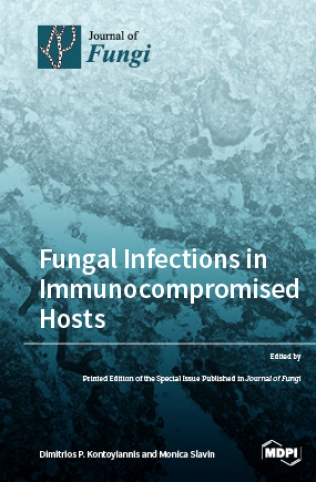Non-Zoonotic Transmission of Sporotrichosis: A Translational Study of Forty-Three Cases in a Zoonotic Hyperendemic Area
IF 4.2
2区 生物学
Q2 MICROBIOLOGY
引用次数: 0
Abstract
Over the past two decades, zoonotic sporotrichosis transmitted by naturally infected cats has become hyperendemic in Rio de Janeiro, Brazil. Sporothrix brasiliensis is the main agent involved. However, there are other forms of transmission of sporotrichosis. The aim of this study was to evaluate and associate the epidemiological, clinical and therapeutic data and the susceptibility of Sporothrix spp. to antifungal drugs in 43 non-zoonotic sporotrichosis cases. Forty-three clinical strains of Sporothrix were identified by partial sequencing of the calmodulin gene. An antifungal susceptibility test of amphotericin B, terbinafine, itraconazole, posaconazole and isavuconazole was performed according to the broth microdilution method. Most patients were male (55.8%). Regarding the source of infection, 21 patients (48.8%) reported trauma involving plants and/or contact with soil. Sporothrix brasiliensis was the predominant species (n = 39), followed by S. globosa (n = 3) and S. schenckii (n = 1). Sporothrix brasiliensis was associated with all the sources of infection, reinforcing previous data showing the presence of this species in environmental sources, as well as with all the clinical forms, including severe cases. One clinical strain of Sporothrix brasiliensis was classified as a non-wild-type strain for amphotericin B and another for itraconazole. S. schenckii was classified as non-WT for all the antifungals tested. In this context, it is important to emphasize that non-zoonotic sporotrichosis still occurs in the state of Rio de Janeiro, with S. brasiliensis as the main etiological agent, primarily associated with infections acquired after traumatic inoculation with plants and/or soil contact, followed by S. globosa and S. schenckii. In addition, non-WT strains were found, indicating the need to monitor the antifungal susceptibility profile of these species. It is crucial to investigate other natural sources of S. brasiliensis to better understand this fungal pathogen and its environment and host cycle.孢子丝虫病的非人畜共患传播:人畜共患病高发区 43 个病例的转化研究
在过去二十年里,由自然感染的猫传播的人畜共患孢子丝菌病已在巴西里约热内卢高发。巴西孢子丝菌病(Sporothrix brasiliensis)是其中的主要病原体。不过,孢子丝菌病还有其他传播方式。本研究的目的是对 43 例非滋扰性孢子丝菌病病例中的流行病学、临床和治疗数据以及孢子丝菌属对抗真菌药物的敏感性进行评估和关联。通过钙调蛋白基因的部分测序,确定了 43 株孢子丝菌的临床菌株。根据肉汤微稀释法对两性霉素 B、特比萘芬、伊曲康唑、泊沙康唑和异武康唑进行了抗真菌药敏试验。大多数患者为男性(55.8%)。在感染源方面,21 名患者(48.8%)报告了涉及植物的外伤和/或与土壤的接触。巴西孢子丝菌(Sporothrix brasiliensis)是最主要的物种(39 人),其次是球孢子丝菌(S. globosa)(3 人)和申克孢子丝菌(S. schenckii)(1 人)。巴西孢子丝菌与所有感染源都有关联,这进一步证实了之前的数据显示该物种存在于环境源中,并与所有临床形式(包括重症病例)都有关联。一种巴西孢子虫临床菌株被列为两性霉素 B 的非野生型菌株,另一种被列为伊曲康唑的非野生型菌株。对于所有测试的抗真菌药物,S. schenckii 都被归类为非野生型菌株。在这种情况下,有必要强调的是,里约热内卢州仍然存在非动物源性孢子丝菌病,其主要病原体是巴西孢子丝菌,主要与植物外伤接种和/或土壤接触后感染有关,其次是球孢子丝菌和申克孢子丝菌。此外,还发现了非 WT 菌株,这表明有必要对这些菌种的抗真菌敏感性进行监测。为了更好地了解这种真菌病原体及其环境和宿主周期,调查其他天然来源的 S. brasiliensis 至关重要。
本文章由计算机程序翻译,如有差异,请以英文原文为准。
求助全文
约1分钟内获得全文
求助全文
来源期刊

Journal of Fungi
Medicine-Microbiology (medical)
CiteScore
6.70
自引率
14.90%
发文量
1151
审稿时长
11 weeks
期刊介绍:
Journal of Fungi (ISSN 2309-608X) is an international, peer-reviewed scientific open access journal that provides an advanced forum for studies related to pathogenic fungi, fungal biology, and all other aspects of fungal research. The journal publishes reviews, regular research papers, and communications in quarterly issues. Our aim is to encourage scientists to publish their experimental and theoretical results in as much detail as possible. Therefore, there is no restriction on paper length. Full experimental details must be provided so that the results can be reproduced.
 求助内容:
求助内容: 应助结果提醒方式:
应助结果提醒方式:


